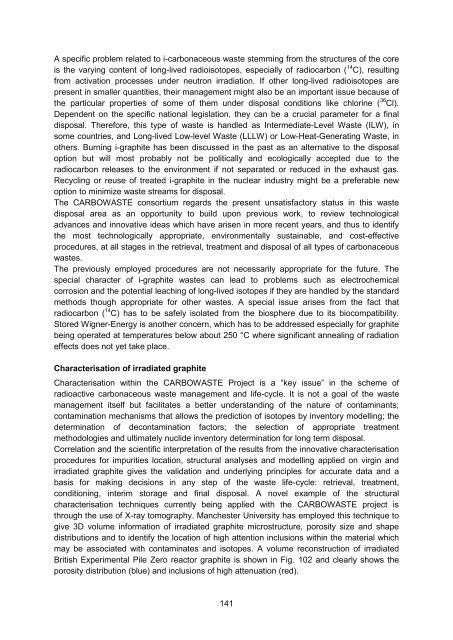Annual Report 2009/2010 - JUWEL - Forschungszentrum Jülich
Annual Report 2009/2010 - JUWEL - Forschungszentrum Jülich
Annual Report 2009/2010 - JUWEL - Forschungszentrum Jülich
Create successful ePaper yourself
Turn your PDF publications into a flip-book with our unique Google optimized e-Paper software.
A specific problem related to i-carbonaceous waste stemming from the structures of the core<br />
is the varying content of long-lived radioisotopes, especially of radiocarbon ( 14 C), resulting<br />
from activation processes under neutron irradiation. If other long-lived radioisotopes are<br />
present in smaller quantities, their management might also be an important issue because of<br />
the particular properties of some of them under disposal conditions like chlorine ( 36 Cl).<br />
Dependent on the specific national legislation, they can be a crucial parameter for a final<br />
disposal. Therefore, this type of waste is handled as Intermediate-Level Waste (ILW), in<br />
some countries, and Long-lived Low-level Waste (LLLW) or Low-Heat-Generating Waste, in<br />
others. Burning i-graphite has been discussed in the past as an alternative to the disposal<br />
option but will most probably not be politically and ecologically accepted due to the<br />
radiocarbon releases to the environment if not separated or reduced in the exhaust gas.<br />
Recycling or reuse of treated i-graphite in the nuclear industry might be a preferable new<br />
option to minimize waste streams for disposal.<br />
The CARBOWASTE consortium regards the present unsatisfactory status in this waste<br />
disposal area as an opportunity to build upon previous work, to review technological<br />
advances and innovative ideas which have arisen in more recent years, and thus to identify<br />
the most technologically appropriate, environmentally sustainable, and cost-effective<br />
procedures, at all stages in the retrieval, treatment and disposal of all types of carbonaceous<br />
wastes.<br />
The previously employed procedures are not necessarily appropriate for the future. The<br />
special character of i-graphite wastes can lead to problems such as electrochemical<br />
corrosion and the potential leaching of long-lived isotopes if they are handled by the standard<br />
methods though appropriate for other wastes. A special issue arises from the fact that<br />
radiocarbon ( 14 C) has to be safely isolated from the biosphere due to its biocompatibility.<br />
Stored Wigner-Energy is another concern, which has to be addressed especially for graphite<br />
being operated at temperatures below about 250 °C where significant annealing of radiation<br />
effects does not yet take place.<br />
Characterisation of irradiated graphite<br />
Characterisation within the CARBOWASTE Project is a “key issue” in the scheme of<br />
radioactive carbonaceous waste management and life-cycle. It is not a goal of the waste<br />
management itself but facilitates a better understanding of the nature of contaminants;<br />
contamination mechanisms that allows the prediction of isotopes by inventory modelling; the<br />
determination of decontamination factors; the selection of appropriate treatment<br />
methodologies and ultimately nuclide inventory determination for long term disposal.<br />
Correlation and the scientific interpretation of the results from the innovative characterisation<br />
procedures for impurities location, structural analyses and modelling applied on virgin and<br />
irradiated graphite gives the validation and underlying principles for accurate data and a<br />
basis for making decisions in any step of the waste life-cycle: retrieval, treatment,<br />
conditioning, interim storage and final disposal. A novel example of the structural<br />
characterisation techniques currently being applied with the CARBOWASTE project is<br />
through the use of X-ray tomography. Manchester University has employed this technique to<br />
give 3D volume information of irradiated graphite microstructure, porosity size and shape<br />
distributions and to identify the location of high attention inclusions within the material which<br />
may be associated with contaminates and isotopes. A volume reconstruction of irradiated<br />
British Experimental Pile Zero reactor graphite is shown in Fig. 102 and clearly shows the<br />
porosity distribution (blue) and inclusions of high attenuation (red).<br />
141
















